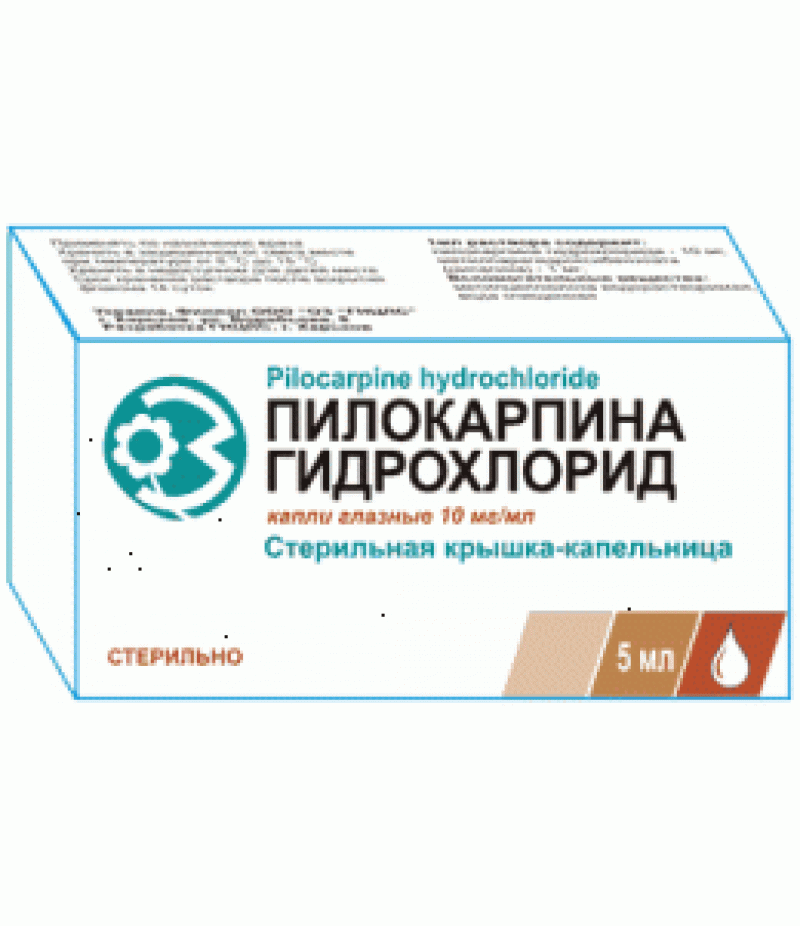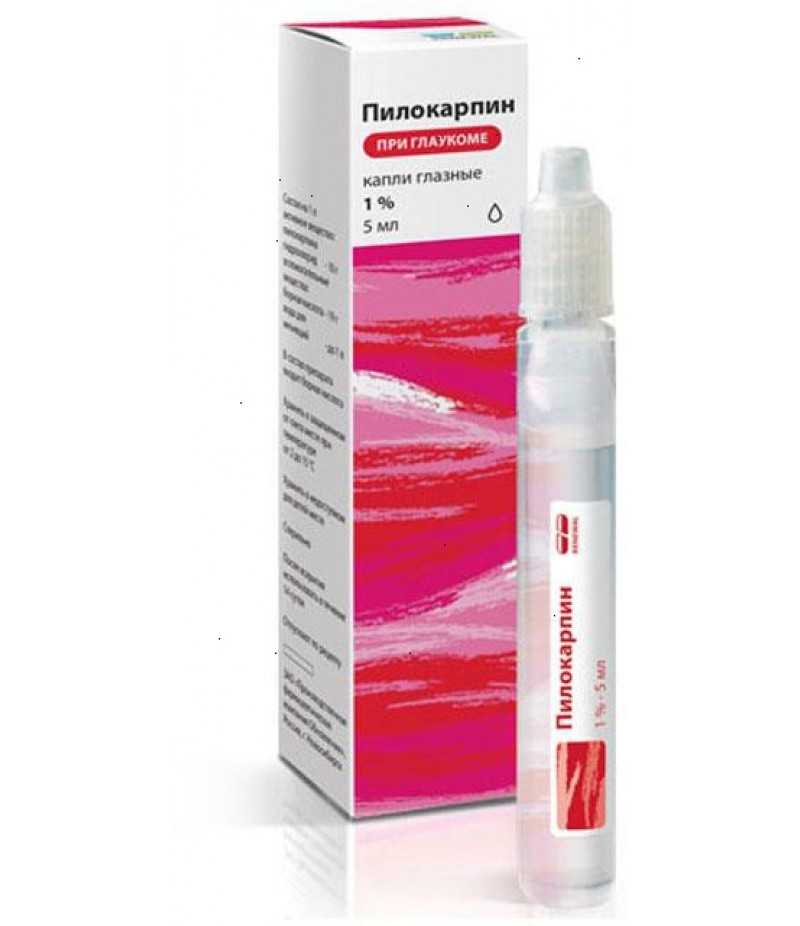Pilocarpine hydrochloride drops 1% 5ml
- $4.31
- 3 or more $4.25
- Availability:In Stock
Pilocarpine hydrochloride instructionYou can buy Pilocarpine hydrochloride hereSee also - PilocarpineComposition per mlActive substance:Pilocarpine hydrochloride - 10 mgExcipients:boric acid 12.5 mgso
Tags: drops
Pilocarpine hydrochloride instruction
You can buy Pilocarpine hydrochloride here
See also - Pilocarpine
Composition per ml
Active substance:
Pilocarpine hydrochloride - 10 mg
Excipients:
boric acid 12.5 mg
sodium hydroxide 1 M to pH 3.5-5.0
water for injection up to 1 ml
Description: Clear, colorless liquid
Pharmacotherapeutic group:
antiglaucoma means - m-cholinomimetic
ATX code: [S01EB01]
Pharmacological properties
M-cholinomimetic, has a miotic and antiglaucomal effect. Increases the secretion of digestive, bronchial and sweat glands, tone of smooth muscles of the bronchi, intestines, bile and bladder, uterus.
Pharmacodynamics
Causes reduction of the ciliary muscle (spasm of accommodation) and muscle, narrowing the pupil (miosis). The contraction of the muscle that narrows the pupil (miosis) leads to a shift in the basal part of the iris from the angle of the anterior chamber of the eye, which facilitates the opening of the Schlemm's canal and fountain spaces with closed-angle glaucoma. Reduction of the ciliary muscle (spasm of accommodation) leads to the discovery of the Schlemm's canal and trabecular gaps in open-angle glaucoma. Due to these processes, the outflow of aqueous humor from the anterior chamber of the eye increases with a further decrease in intraocular pressure. The hypotensive action of pilocarpine begins in 10-30 minutes. The duration of the hypotensive effect with a single instillation of pilocarpine solution varies individually and on average is 4-6 hours. Intraocular pressure is reduced by 4-8 mm Hg. (17-20% of the initial level).
With primary open-angle glaucoma, instillation of 1% solution causes a decrease in intraocular pressure by 25-26%. The onset of the effect - after 30-40 minutes, reaches a maximum after 1.5-2 hours and lasts for 4-14 hours.
Pharmacokinetics
Pilocarpine hydrochloride penetrates well through the cornea, it is well absorbed through the conjunctiva. In the conjunctival sac is almost not absorbed. With topical application, its concentration in the aqueous humor of the eye reaches a maximum (Tcmax) 30 minutes after the installation. It is retained in the tissues of the eye, which increases its half-life from the eye tissues (T1 / 2), which is 1.5-2.5 hours.
Pilocarpine hydrochloride is not metabolized in the tissues of the eye and is excreted unchanged with intraocular fluid. Pilocarpine hydrochloride is converted into an inactive form by hydrolysis in blood serum and liver. The half-life of the plasma is about 30 minutes.
Indications for use
acute attack of angle-closure glaucoma;
secondary glaucoma (vascular, post-traumatic (burns));
primary open-angle glaucoma (in combination with β-blockers or other drugs that reduce intraocular pressure);
the need to narrow the pupil after the installation of mydriatic.
Contraindications
Iritis, iridocyclitis and other conditions in which the narrowing of the pupil is not recommended (for example, after surgical intervention on the eye, except when it is necessary to narrow the pupil directly after surgery to prevent the formation of synechia), hypersensitivity to pilocarpine, children under 18 years of age , retinal detachment (including history), as well as conditions predisposing to detachment of the retina.
If you have any of these diseases, consult a doctor before taking the drug.
Carefully
In young patients with high degree of myopia.
If you have any of these diseases, consult a doctor before taking the drug.
Application in pregnancy and during breastfeeding
It is possible to use pilocarpine hydrochloride to treat pregnant and lactating mothers as prescribed by the doctor if the expected benefit to the mother exceeds the potential risk to the fetus and the baby.
Dosing and Administration
Bury in the conjunctival sac 1-2 drops. The number of installations can vary depending on the indications and individual sensitivity of the patient.
Acute attack of closed glaucoma: during the first hour the solution of pilocarpine hydrochloride is instilled every 15 minutes, 2-3 hours every 30 minutes, 4-6 hours every 60 minutes, and further 3-6 times a day, until the seizure occurs.
Secondary glaucoma (vascular, posttraumatic (burns)): 1-2 drops 2-4 times a day;
Primary open glaucoma: 1-2 drops 2-4 times a day in combination with β-blockers or other drugs that reduce intraocular pressure;
To narrow the pupil after the installation of mydriatic: 1-2 drops once.
Side effects of Pilocarpine hydrochloride
Headache (in the temporal and periorbital regions), short-term pain in the eye area; myopia; decreased vision, especially in the twilight, due to the development of persistent miosis and spasm of accommodation; lacrimation, rhinorrhea, superficial keratitis; allergic reactions.
With prolonged use, it is possible to develop follicular conjunctivitis, contact dermatitis of the eyelids and reversible opacification, the lens.
Systemic side effects are rare. Pilocarpine hydrochloride as m-cholino-mimetic can cause bronchospasm, slow heart rate, increase saliva, rhinorrhea.
If any of the side effects listed in the manual are aggravated, or if you notice any other side effects not listed in the instructions, tell your doctor.
Overdose
When overdose is possible increased salivation, sweating, bradycardia, the development of bronchospasm, lowering blood pressure.
When ingestion is possible poisoning, manifested a significant increase in m-holinomimeticheskih effects, including. with the development of severe heart failure and bronchoconstriction.
Treatment: gastric lavage; monitoring heart rate (heart rate), blood pressure (BP), respiratory function; administration of atropine (0.5-1.0 mg subcutaneously or intravenously), epinephrine (0.3-1.0 mg subcutaneously or intravenously).
Interaction with other medicinal products
Pilocarpine hydrochloride antagonists are atropine and other m-holinoblokatory.
With simultaneous application with adrenomimetics, antagonism of action (per pupil diameter) can be observed.
Timolol and phenylephrine increase the decrease in intraocular pressure, reducing the production of intraocular fluid.
It is possible to use pilocarpine hydrochloride in combination with sympathomimetics, β-adrenoblockers, inhibitors of carbonic anhydrase.
M-cholinomimetic activity of pilocarpine hydrochloride is reduced by tricyclic antidepressants, phenothiazine derivatives, chlorprotixen, clozapine; is enhanced by cholinesterase inhibitors.
It is possible to develop bradycardia and decrease blood pressure during general anesthesia with halothane (in patients who use pilocarpine hydrochloride in eye drops).
special instructions
Treatment should be performed with regular monitoring of intraocular pressure.
To reduce absorption, it is recommended after the installation to pinch the eye canal for 1-2 minutes, pressing the finger at the inner corner of the eye.
Due to the development of persistent miosis, as well as the myopic effect associated with a change in accommodation, it is possible to reduce visual acuity, therefore, the use of the drug is not recommended for drivers of vehicles during the twilight and night time, care must be taken when engaging in potentially hazardous activities requiring increased concentration and the speed of psychomotor reactions.
The use of pilocarpine hydrochloride is not recommended when wearing soft contact lenses.
Form of issue.
Eye drops 1%.
1.5 ml, 2 ml or 5 ml in a tube-dropper polymer. 1, 2, 4, 5 or 10 tubes with IV instructions are placed in a pack of cardboard.
The text of the instruction for the use of a tube-dropper is printed on the packet.
5 ml or 10 ml into the bottle-dropper polymer. 1 or 2 vials of a dropper with instructions for the use of the drug are placed in a pack of cardboard.
The text of the instruction for the use of the dropper bottle is printed on the packet.
5 ml into glass bottles.
1 bottle complete with a sterile cap-dropper and instruction on the use of the drug is placed in a pack of cardboard.
5 vials into the contour cell package.
1 circuit cell package complete with 5 sterile dropper caps and instructions for use of the drug are placed in a pack.
Storage conditions
In the dark place at a temperature of no higher than 15 ° C for the drug in a tube of droppers and a bottle of droppers in a dark place at a temperature of no higher than 25 ° C for the drug in glass vials. Keep out of the reach of children.
Shelf life
3 years for the drug in vials; 2 years for the drug in a tube-droppers, a bottle-droppers.
After opening the tube-dropper, the bottle-dropper and bottle - 1 month.
Do not use after the expiry date printed on the package.
Leave conditions
You don't need a prescription to buy pilocarpine hydrochloride online.


